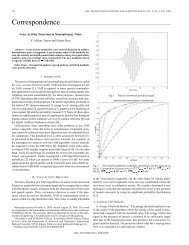Thesis (PDF) - Signal & Image Processing Lab
Thesis (PDF) - Signal & Image Processing Lab
Thesis (PDF) - Signal & Image Processing Lab
Create successful ePaper yourself
Turn your PDF publications into a flip-book with our unique Google optimized e-Paper software.
Chapter 4<br />
The “trench” problem and the<br />
proposed solutions<br />
The BTV-domain morphological operators (erosion, opening etc.) proposed by Keshet<br />
in [16] are self-dual. This means that those operators treat bright and dark “objects”<br />
similarly. However, when applying those operators, a “trench” problem may arise.<br />
This chapter studies this problem, and proposes solutions for it.<br />
The BTV-domain morphological filtering approach involves three steps. First, the<br />
BTV transform is performed on the input image, using the TD-tree representation<br />
of the image. Then the transformed image is simplified using morphological filtering,<br />
based on the partial ordering of images of alternating sequences, defined in Section<br />
2.5.4. Finally output image is constructed from the processed image by an inverse<br />
BTV transform, using Equation (2.21).<br />
Figs. 4.1 and 4.3 show the output of the erosion ˆεB on two test images. Figs. 4.2<br />
and 4.4 show the corresponding opening ˆγB of the same two test images.<br />
Notice that the results of self-dual erosion and opening (Figs. 4.1-4.2) on the<br />
synthetic image are as expected. The corresponding erosion has the effect of shrinking<br />
all the elements of the image, regardless to their contrast. The opening rounds the<br />
corners that SE can not get into in all the elements of the image, bright and dark.<br />
However, the results on the natural image are very strange; the output shows<br />
many “trenches” that do not appear to have any justification to exist.<br />
These are typical results. When the number of gray levels is small, and the image<br />
is not very complex, the BTV-based erosion returns useful results. However, when<br />
44
















